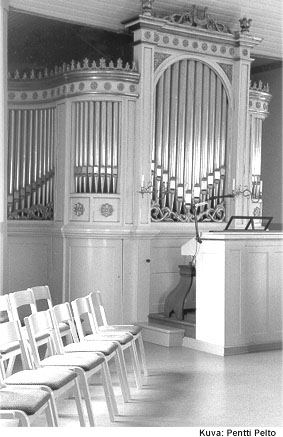
|
HISTORICAL ORGANS IN FINLAND 
Närpiö, Rangsby- Zachariassen, Jens Alexander 1881
- 20 stops, 2 manuals and pedal
- mechanical action and mechanical stop action
When a new organ was acquired for Närpiö Church in 1950, the previous organ — a Zachariassen organ built in 1881 — was transferred to the village church of Rangsby. In Rangsby Church, the organ is placed on the floor of the transept in a slightly cramped location; the side walls of the organ have had to be discarded. A blower has been added, but the organ can still be played with the bellows operated by foot. Because of its size, its quality and certain unique details, the Rangsby instrument is highly valuable.
Appearance
The façade of the Rangsby organ is shaped like a double cornice, probably mimicking the shape of the parapet of the (now dismantled) organ loft in Närpiö Church. The forward flat is symmetrical and contains 11 pipes. The front corners have convex flats of equal height, and the concave portions of the cornices have oblong flats. The top of the façade has a frieze decorated with rosettes. There is little decoration, but the unusual shape makes the façade fascinating and interesting. Only some of the façade pipes speak, a feature typical for Zachariassen.
The organ has an in-line arrangement. The swell box of Manual II is in the narrow front part of the façade. The Manual I chest is behind this, followed by the tuning access space and the Pedal chest. At the very rear is a group of five box bellows. The chests are placed fairly low down, because there was not much vertical space in the organ loft of Närpiö Church.
Technical features
The console is in front of the organ, and the organist sits facing the church. The console is so low that the organist can see over it. The stop knobs, which are rather large and have a lengthy movement, are terraced on both sides of the keyboards typically for the builder. The stop names are embossed in large letters on the porcelain ends of the stop knobs. The console also has the necessary coupling pedals and forte pedals, one to activate certain powerful stops and the other to deactivate them — a solution to the organist’s perennial problem of activating a loud or soft registration quickly. This arrangement also implies that early 19th-century registration was not very complicated. The mechanical action runs under the console to the organ.
The Manual II action is connected to a separate box right under the façade, containing a Harmonium 8’ stop. This stop has free reeds and no resonators. Unlike a conventional harmonium, this device runs on compressed air, and the reeds are fitted with tiny tuning hooks enabling fine-tuning. This is the only preserved and functional harmonium stop in Finland. The free-reed Bassun (Posaune) 16’ stop in the Pedal is another curiosity which seems to be the only one of its kind in historical Finnish organs. The chests are lamellar slider chests typical of Zachariassen in their details.
Musical properties
The action is sturdy but sensitive. Because of its great mass, playing the instrument may seem heavy, especially in rapid passages. Thus, slow tempos are better suited to the properties of the instrument.
The sound is fairly powerful, due in part to the fact that the organ is currently in a space smaller than that for which it was originally designed. There are clear connections to German Romanticism in its sound, but the overall impression is brighter and clearer. The harmonium stop, together with the free-reed Bassun which is particularly soft, add a special soft colour to the sound. Zachariassen’s Gemshorn is almost a violin stop, and his Flauto major is actually a double-lipped full-bodied Dubbelflöjt.
Disposition
Manual I C-f3 | Manual II C-f3 | Pedal C-d1 |
Borduna 16’ | Geig.principal 8’ | Violon 16’ |
Principal 8’ | Rörflöte 8’ | Subbas 16’ |
Spitzflöte 8’ | Viola di Gamba 8’ | Violoncello 8’ |
Flauto major 8’ | Flöte amabile 8’ | Oktava 4’ |
Oktava 4’ | Flûte octaviante 4’ | Bassun 16’ |
Gemshorn 4’ | Harmonium 8’ | |
Oktava 2’ | | |
Cornet 1-3chor | | |
Trompet 8’ | | |
| | |
| | |
| | |
| | |
|
|
|
Couplings: II-I, I-Ped, II-Ped, I 4’ | | |
One of the forte pedals activates these stops, | | |
the other deactivates them: Tro 8 – Okt 2 – Cor 1-3. | | |
| | |
| | |
| | |
| | |
| | |
| | |
| | |
| | |
| | |
| | |
|